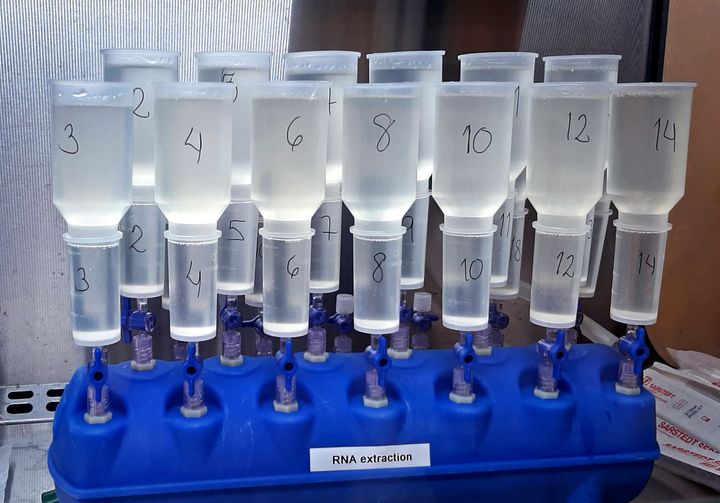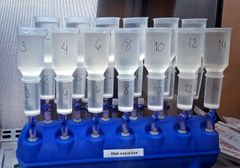Sewage monitoring method can trace source of child hepatitis outbreaks

Researchers in Sweden have created a method that now makes it possible to monitor sewage for a virus that has is believed to be linked to hepatitis outbreaks worldwide. First developed for the Covid-19 pandemic, the method can be adapted for a number of viruses, including monkey pox, offering a valuable addition to the public health toolkit.
In a recent study conducted by researchers from KTH Royal Institute of Technology in Stockholm, adenovirus F41 was detected in wastewater samples at the Swedish Environmental Epidemiology Center-KTH node in Stockholm. The results were presented in September to the European Commission and Swedish authorities.
The F41 virus is known for causing outbreaks of gastroenteritis in children—which typically causes diarrhea and vomiting—a condition parents often refer to as “stomach flu.” But a recent outbreak in the U.S. suggested that F41 may also lead to liver inflammation.
Several children in Alabama were hospitalized during the summer with hepatitis symptoms but they tested negative for hepatitis, while testing positive for F41. That outbreak led the U.S. Centers for Disease Control to begin an investigation into the possibility of a link between F41 and hepatitis A, B and C.
KTH researchers Zeynep Cetecioglu Gurol and Mariel Perez Zabaleta say that in the event of such outbreaks, the method could be used by public health authorities to trace the source. “If we know the water system plan, we can collect wastewater samples close to schools, hospitals or airports,” Cetecioglu Gurol says “Even if wastewater is mixed from multiple parts of a community, the samples are going to be more concentrated than the samples taken directly from the wastewater treatment plants.”
The researchers adapted a sampling technique that had first been created at KTH in 2020 to monitor Covid-19 virus particles in wastewater collected at Stockholm’s sewage treatment facilities. Perez Zabaleta says the technique can also be used to detect not only F41 but monkey pox and seasonal viruses such influenza and norovirus.
She says the researchers are now adapting their methods to detect the presence of antibiotic resistance via sewage samples.
Keywords
Images
Links
About KTH Royal Institute of Technology
Founded in 1827, KTH Royal Institute of Technology in Stockholm is one of the world's leading technical and engineering universities, as well as a key center of intellectual talent and innovation.
Subscribe to releases from KTH Royal Institute of Technology
Subscribe to all the latest releases from KTH Royal Institute of Technology by registering your e-mail address below. You can unsubscribe at any time.
Latest releases from KTH Royal Institute of Technology
AI helps decode horses' body language for better veterinary care9.4.2025 12:20:55 CEST | Press Release
Researchers are using AI to bridge the communication gap between horse and human. Combining 3D motion capture and machine learning, a new modeling system would equip veterinarians with a powerful visual tool for interpreting equine body language—the key to detecting physical and even behavioral problems.
New Swedish Initiative to Integrate Research and Healthcare4.4.2025 11:37:56 CEST | Press Release
A groundbreaking national initiative, Precision Omics Initiative Sweden (PROMISE), aims to connect research with healthcare and establish Sweden as a world leader in data-driven precision medicine.
For graphene production, a potential green alternative to mining graphite3.3.2025 14:14:40 CET | Press Release
Researchers in Sweden report a green alternative to reduce reliance on mining graphite, the raw source behind the "wonder material" graphene.
AI on aircraft can help prevent stalls and terrifying drops in altitude17.2.2025 15:58:14 CET | Press Release
Artificial intelligence could help prevent terrifying mid-air drops in altitude. In a new study, an international research team successfully tested a machine learning system for preventing trouble with turbulence.
Alternative to studded winter tires reduces airborne particles by 20 percent6.2.2025 14:41:07 CET | Press Release
On icy roads, studded winter tires can save lives – but they pulverize pavement and fill the air with dangerous, inhalable particles. A new Swedish study shows that both road wear and airborne particles could be reduced by as much as 20 percent if studs were made instead with an alternative hard metal.
In our pressroom you can read all our latest releases, find our press contacts, images, documents and other relevant information about us.
Visit our pressroom
